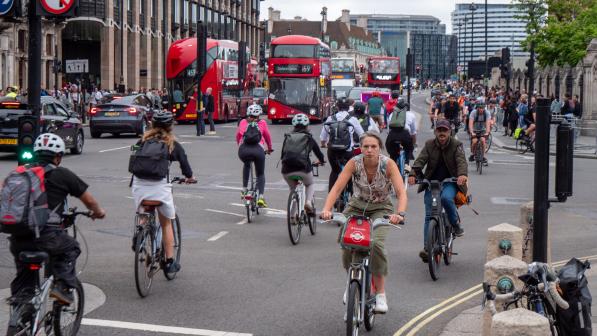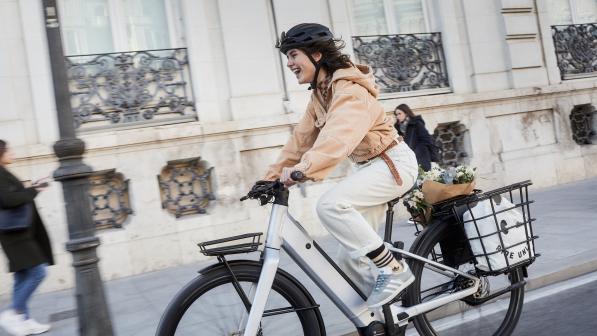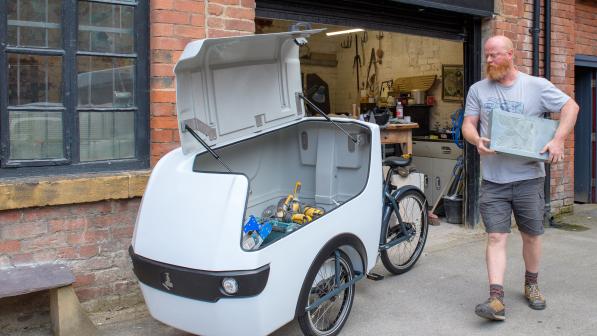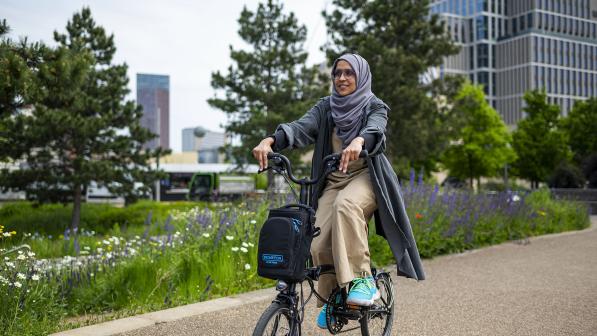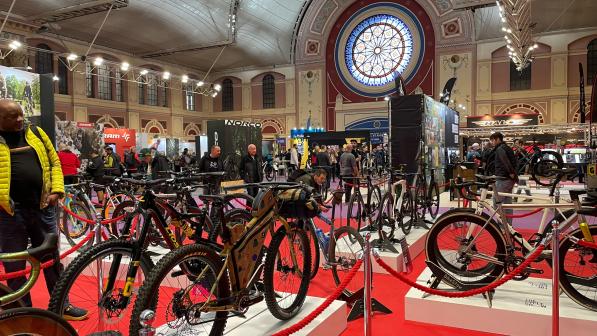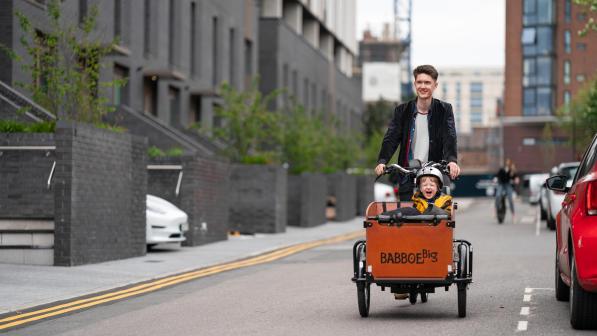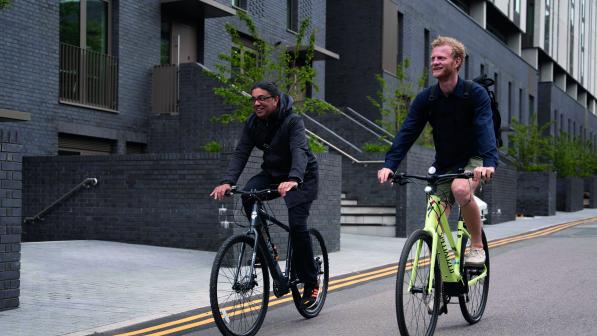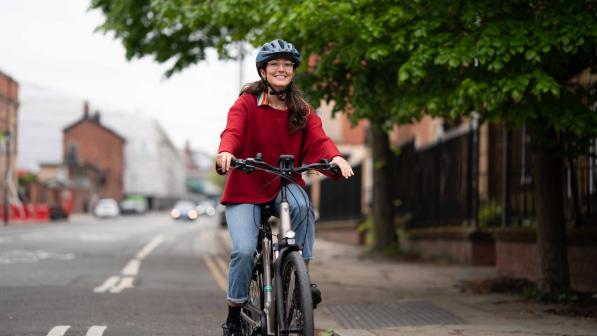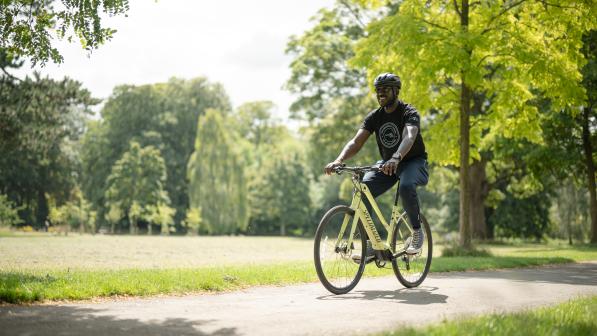The people making the switch from car to e-cycle

E-bikes are part of the solution to the problems caused by the overuse of cars. They promote active travel as they enable people to incorporate exercise into their everyday journeys more easily, which brings mental and physical health benefits. They’re much better for the global and local environment than combustion engines. And they’re way cheaper than driving – a welcome benefit in the current cost-of-living crisis.
According to research by World Bicycle Industry Association, e-bikes now account for 10% of global bicycle sales. More people than ever are warming to the idea of a little assistance as they pedal – and some are using an e-bike instead of a car for local journeys.

Just what the doctor ordered
Cycling UK member Dr Jonathan Leach (right) is a GP who is in his sixties. Before purchasing a Brompton Electric, he used to drive 20km from his home in Worcester to his surgery in Bromsgrove, then drive between home visits during the day. Now he chooses to pedal.
“Having an electric bike makes commuting to and from work a lot quicker,” he said. “I’m able to bypass traffic congestion in the town centre, which is a huge bonus, especially at rush hour.”
As a medical professional, Dr Leach is well versed in the importance of regular exercise. His e-bike allows him to keep moving and keep fit, even during his busiest workdays. “I regularly arrive at home visits on my e-bike, and for many patients, who are very frail, very elderly and very lonely, watching me pedal into their driveway on my e-bike is the highlight of their week,” he said.
He encourages patients to follow his lead and often suggests using an e-bike for short journeys, especially if they struggle with mobility or have health issues such as osteoarthritis. “I think that e-bikes are a real game changer,” he said. “They allow people to cycle who otherwise might not be able to. I always reassure patients that they’re not ‘cheating’ on an e-bike as they will get nearly all the same benefits as they would pedalling a conventional bike.”

E-bikes don’t have the same barriers to ownership as electric cars. They’re much cheaper to buy and they don’t require an extensive charging network; any standard electric socket is sufficient. Yet e-bikers need good infrastructure just as much as regular cyclists – perhaps more so because a newcomer to everyday cycling is more likely to be tempted by an e-bike than an unpowered one.
For experienced cyclists like Dr Leach, a lack of segregated cycle tracks and cycle lanes is annoying but not enough to stop him riding. “I would argue that cycling infrastructure in my area is poor,” he said. “Despite there being no cycling lanes, a taxi driver recently beeped his horn at me relentlessly because I was cycling on the road and he couldn’t get past quickly enough due to oncoming traffic.”
Nevertheless, Dr Leach has pedalled 5,000km on his e-bike over the last year. That means he’s cycled far more than he has driven. “Using my e-bike has, without a doubt, saved me a significant amount of money,” he said.

Money matters
The big savings an e-bike offers compared to every other form of transport (apart from walking and unassisted cycling) come from the minimal day-to-day expenditure. It costs pennies to charge an e-bike’s battery. The initial purchase price can seem high, however. E-bike prices at the UK’s largest e-bike supplier currently start at £599, while top-quality models cost from £2,500 upwards.
To put it into perspective, that’s still a fraction of what’s spent on cars. According to Auto Trader, the average price of a used car in July 2022 was over £17,000, 19.5% higher than the cost one year prior. Additionally, with the recent rise in fuel prices, drivers are spending more than ever to fill up. Research by the Department for Transport found that the average UK driver now spends £107 on petrol per month or £149 on diesel.

If an e-bike’s purchase price is a stumbling block, the easiest way to make it more affordable is to get it through the Cycle to Work scheme. It’s a government initiative to encourage cycle commuting that enables participants to save 25-39% on the price of a new bike and equipment – and to pay in instalments. There used to be a default limit of £1,000 for Cycle to Work purchases, which ruled out most good-quality e-bikes. For the majority of Cycle to Work providers – for example, Cyclescheme – that no longer applies.
The average recommended retail price of an e-bike purchased through Cyclescheme is £3,000. But for the sake of argument, let’s say you want to spend only £1,000 on an e-bike. If you’re on an average salary and got it through Cyclescheme, you’d pay less than £60 per month for a year for it, followed by an ‘ownership fee’ of £70 – in total, £750 instead of £1,000. The only other costs would be on occasional maintenance, charging, and a replacement battery some years down the line.

Ask the family
Menna Jenkins is a mum who used the Cycle to Work scheme to get a Tern GSD e-cargo bike. When roadworks started on the route she drove her children to school every day, she noticed that the journey was taking almost twice as long. After a test ride on a Tern GSD e-cargo bike from her local bike shop, she decided to buy her own.
“At first I was very hesitant,” she said. “I wasn’t sure what it would feel like to ride, and if it would be too heavy. But I couldn’t believe how responsive it was when I rode it up and down a hill for the first time.”
The e-cargo bike allows Menna and her two children to ride along a canal towpath and bypass the traffic congestion and roadworks completely. She said: “We hardly use our car during the week anymore, which has saved us a lot of money. We used to buy fuel a couple of times per month. Now a full tank lasts us a month, if not longer.”
Menna was delighted to discover how much her children enjoyed starting their day on the e-cargo bike, sitting inside a passenger compartment that Tern calls the Clubhouse. “We found some little velcro pockets in Decathlon, which we added to that,” she said. “The girls are able to pop their water bottles, snacks, gloves and cuddly toys in there, which makes it their own cosy space. The canopy covers the girls from wind and rain; they’re still quite small so we felt that they needed that extra bit of shelter. Our e-cargo bike came with lights, which was great, but we decided to add a front rack to carry school bags.”

Like other e-bikes, Menna’s Tern GSD only provides assistance when she’s pedalling. Every journey therefore requires some effort. How much depends on how strenuous the journey is and on which assistance mode is selected; most e-bikes have a choice of three or four. Under UK law, an e-bike’s motor assistance must cut out at 25km/h (15.5mph), with a maximum sustained power of 250W. That’s a lot – as much as a fit cyclist working fairly hard – and it makes a huge difference on hills.
Having recently returned from maternity leave when she started using her e-cargo bike, Menna found that the electric assistance gave her the confidence to cycle regularly and really helped to pedal up the hill near her house. “I was worried about my fitness,” she said, “not just because I’d just had a baby, but also because I work from home so it’s harder to find time to exercise.”
Despite her concerns, Menna has enjoyed riding her e-bike and has already seen improvements in her fitness. She said: “Even though the kids have grown and they’re heavier, I’ve noticed that it takes less effort than a few months ago to climb hills.”

Making cycling e-asier
The Cycle to Work scheme isn’t the only easy entry point to e-biking. Cycling UK’s Making Cycling E-asier project, which launched in May 2022, offers free one-month e-cycle loans, plus skills and confidence sessions, to communities in Manchester, Leicester, Sheffield, and Luton and Dunstable. It gives people the opportunity to feel the benefits of using an e-cycle for short, everyday journeys, so that they can decide whether to get one for long-term use.
Derrick Udusegbe is someone who did just that. When he heard about Making Cycling E-asier, he and his wife, Success, signed up right away. Through the scheme, the couple received two free, one-month e-cycle loans. Derrick pedalled off from Khizra Mosque in Manchester on a Specialized Vado SL 4.0, Success on a Raleigh Motus Tour Plus.
The couple added child seats to the e-bikes so the whole family could travel by e-bike to pick up groceries and run daily errands. “The kids get so excited when we use the e-bikes to go anywhere,” said Derrick. “They love watching the world go by as we pedal. And whenever our youngest child won’t go to sleep, we pop him in the carrier seat, start cycling and he falls asleep straight away.”
One hurdle the couple encountered was storage space. “We don’t have a lot of extra space in our house to keep the e-bikes,” Derrick said. So they purchased a small but sturdy bike shed to securely store them.

While some people consider e-bikes to be ‘cheating’ (although it’s not clear how you can ‘cheat’ at cycling to work or the shops), Derrick has already found that his fitness is improving. Even with the extra assistance, he’s getting frequent exercise he wouldn’t otherwise have had. “Manchester is very hilly,” he said. “I used to dread cycling uphill, but my e-bike allows me to reach the top without feeling very out of breath. It makes it more enjoyable and I am also pleased to have lost a lot of weight.”
Despite owning two cars, the couple discovered that since they started riding their e-bikes for everyday trips, they no longer use one of them. They plan to sell it. “Like most people, we’ve noticed that things are much more expensive than they were this time last year,” Derrick said. “So we’re always looking for ways to save money. Our second car now sits gathering dust so we intend to sell it.”
As well as helping the family’s finances, using e-bikes instead of a car for short, everyday journeys will help tackle road congestion and reduce the harmful emissions that accelerate climate change. The more people there are that do this, the better off we’ll all be. According to the Department for Transport, at the end of June 2022 there were 40.7 million licensed vehicles in the UK, an increase of 0.6% compared to June 2021. We need to reduce emissions from vehicles, not raise them.
See our help and advice on which e-bike to buy.

New year, new e-bike?
Don’t miss your chance to win one of two e-bikes in Cycling UK’s New Year raffle. We’ve got an Islabikes eJoni step-through (worth £2,599.99) and a Raleigh e-bike (worth £1,699) up for grabs. You can also win amazing prizes from Muc-Off, Carradice, Cannondale, Stolen Goat and more.
Tickets for the online raffle cost just £1 each. Every ticket purchased helps support Cycling UK’s campaigning and charitable work to enable millions more to cycle. To take part, purchase your tickets by the closing date of 28 February. For more details on what you can win and how to enter, see page 12 of your Cycle magazine.
